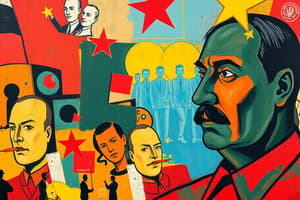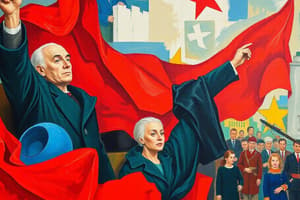Podcast
Questions and Answers
What was one of the causes of the Russian Revolution?
What was one of the causes of the Russian Revolution?
- Stable political system with popular support
- Discontent due to Russia's military struggles during World War I (correct)
- Successful economic reforms by Tsar Nicholas II
- Industrial growth and resource abundance
Which key figure played a pivotal role in organizing the Russian Revolution and establishing the Soviet Union?
Which key figure played a pivotal role in organizing the Russian Revolution and establishing the Soviet Union?
- Alexander Kerensky
- Grigori Rasputin
- Vladimir Lenin (correct)
- Leon Trotsky
Who was known for holding disproportionate influence over the Tsar and his family, contributing to the disillusionment with the Tsarist regime?
Who was known for holding disproportionate influence over the Tsar and his family, contributing to the disillusionment with the Tsarist regime?
- Leon Trotsky
- Vladimir Lenin
- Grigori Rasputin (correct)
- Alexander Kerensky
What did the Russian Revolution ultimately lead to?
What did the Russian Revolution ultimately lead to?
What event in 1917 marked the overthrow of the Tsarist government in Russia?
What event in 1917 marked the overthrow of the Tsarist government in Russia?
Who led the Bolsheviks during the October Revolution of 1917?
Who led the Bolsheviks during the October Revolution of 1917?
What government took control after the February Revolution but failed to address growing issues?
What government took control after the February Revolution but failed to address growing issues?
Which peace treaty did the Bolsheviks sign in 1918, ceding vast territories to Germany?
Which peace treaty did the Bolsheviks sign in 1918, ceding vast territories to Germany?
What major historical impact did the Russian Revolution have on the world?
What major historical impact did the Russian Revolution have on the world?
Which cultural movement emerged as a result of the Russian Revolution, inspiring art and literature?
Which cultural movement emerged as a result of the Russian Revolution, inspiring art and literature?
Study Notes
Unraveling the Russian Revolution: A Class 9 Overview
The Russian Revolution, which unfolded over two distinct periods in 1917, was a transformative event that reshaped the world's political landscape. Let's explore the causes, key figures, events, and impacts of this pivotal moment in history.
Causes of the Russian Revolution
- World War I: Russia's military struggles and casualties led to discontent among the public.
- Economic Hardship: The loss of industrial capacity, poor management, and a lack of resources exacerbated poverty.
- Unpopular Reforms: Tsar Nicholas II's half-hearted efforts to appease the people left many unconvinced.
- Political Unrest: Growing dissatisfaction with the autocratic system of government.
Key Figures
- Vladimir Lenin: A leader of the Marxist Bolshevik faction, Lenin played a pivotal role in organizing the revolution and establishing the Soviet Union.
- Leon Trotsky: A founder of the Red Army, Trotsky was a key strategist in the Bolsheviks' rise to power.
- Grigori Rasputin: An infamous religious figure who held disproportionate influence over the Tsar and his family, Rasputin's fall from grace contributed to the people's disillusionment with the Tsarist regime.
- Alexander Kerensky: A moderate socialist and the leader of the Provisional Government, Kerensky was unable to resolve the nation's crises.
Events
- February Revolution (1917): Workers and soldiers in Petrograd overthrew the Tsarist government, sparking a series of revolts across the nation.
- Provisional Government (1917): A coalition government of liberals and socialists took control, but it failed to address the growing issues.
- October Revolution (1917): The Bolsheviks, led by Lenin, seized power and established a new government.
- Treaty of Brest-Litovsk (1918): The Bolsheviks signed this peace treaty with Germany, ceding vast territories in exchange for an end to war.
Impacts of the Russian Revolution
- Rise of Communism: The Soviet system replaced the Tsarist monarchy, paving the way for the spread of communism globally.
- International Conflict: The Russian Revolution and the Soviet system fostered Cold War tensions and conflicts.
- Economic Shifts: The Soviet Union's industrialization and collectivization efforts had a lasting impact on the nation's economy.
- Cultural Influence: The Russian Revolution inspired art, literature, and music, giving rise to a new cultural movement known as Constructivism.
- Human Rights: The Bolsheviks' authoritarian rule and the suppression of opposition led to widespread human rights abuses.
The Russian Revolution profoundly reshaped the political, social, and economic landscapes of Russia and the world. Its legacy continues to shape our understanding of history and the complexities of political power. (No search results directly related to the Russian Revolution provided. However, the information presented is derived from general knowledge and a casual understanding of the topic.)
Studying That Suits You
Use AI to generate personalized quizzes and flashcards to suit your learning preferences.
Description
Test your knowledge on the causes, key figures, events, and impacts of the Russian Revolution that unfolded in 1917. Explore the transformative moments that reshaped the political landscape of Russia and the world.




